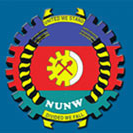Related Research Articles

The International Confederation of Free Trade Unions (ICFTU) was an international trade union. It came into being on 7 December 1949 following a split within the World Federation of Trade Unions (WFTU), and was dissolved on 31 October 2006 when it merged with the World Confederation of Labour (WCL) to form the International Trade Union Confederation (ITUC).

The Communications Workers of America (CWA) is the largest communications and media labor union in the United States, representing about 700,000 members in both the private and public sectors. The union has 27 locals in Canada via CWA-SCA Canada representing about 8,000 members. CWA has several affiliated subsidiary labor unions bringing total membership to over 700,000. CWA is headquartered in Washington, D.C., and affiliated with the AFL–CIO, the Strategic Organizing Center the Canadian Labour Congress, and UNI Global Union. The current president is Chris Shelton.

The Canadian Labour Congress, or CLC is a national trade union centre, the central labour body in Canada to which most Canadian labour unions are affiliated.
Trade Unions in India are registered and file annual returns under the Trade Union Act (1926). Statistics on Trade Unions are collected annually by the Labour Bureau of the Ministry of Labour, Government of India. As per the latest data, released for 2012, there were 16,154 trade unions which had a combined membership of 9.18 million. The Trade Union movement in India is largely divided along political lines and follows a pre-Independence pattern of overlapping interactions between political parties and unions. The net result of this type of system is debated as it has both advantages and disadvantages. According to the data submitted by various trade unions to the Ministry of Labour and Employment as part of a survey, INTUC with a combined membership of 33.3 million, has emerged as the largest trade union in India as of 2013.
Education International (EI) is a global union federation (GUF) of teachers' trade unions consisting of 401 member organizations in 172 countries and territories that represents over 30 million education personnel from pre-school through university. It is one of the world's largest sectoral global union federations.

The International Union of Food, Agricultural, Hotel, Restaurant, Catering, Tobacco and Allied Workers' Associations (IUF) is a global union federation of trade unions with members in a variety of industries, many of which relate to food processing.
The Australian Workers' Union (AWU) is one of Australia's largest and oldest trade unions. It traces its origins to unions founded in the pastoral and mining industries in the late 1880s and it currently has approximately 80,000 members. It has exercised an outsized influence on the Australian Trade Union movement and on the Australian Labor Party throughout its history.
The Workers' Union was a general union based in the United Kingdom, but with some branches in other countries. During the 1910s, it was the largest general union in the UK, but it entered a rapid decline in the 1920s, and eventually became part of the Transport and General Workers' Union (TGWU).
Labour unions emerged in Japan in the second half of the Meiji period, after 1890, as the country underwent a period of rapid industrialization. Until 1945, however, the labour movement remained weak, impeded by a lack of legal rights, anti-union legislation, management-organized factory councils, and political divisions between “cooperative” and radical unionists.
Community is a British trade union which formed in 2004. The union represents workers in a diverse range of sectors, including iron and steel, justice and custodial, domestic appliance manufacturing, textiles and footwear, road transport, betting, the third sector, education and early years as well as the self-employed.
The General Federation of Workers Trade Unions in Bahrain(Formerly known as the General Committee for Bahrain Workers) (GFWTUB) is a national trade union federation in Bahrain. It was established in 2002, by the Workers Trade Union Law granting workers the right to organize collectively.

The Japanese Trade Union Confederation (JTUC), commonly known as RENGO, is the largest national trade union center in Japan, with over six million members as of 2011. It was founded in 1989 as a result of the merger of the Japan Confederation of Labor (Domei), the Federation of Independent Unions (Churitsuroren) and the National Federation Of Industrial Organisations (Shinsambetsu). In 1990, the General Council of Trade Unions of Japan (Sohyo) also joined RENGO.

The National Union of Namibian Workers (NUNW) is one of three national trade union centers in Namibia. It was established in 1970 and is affiliated with SWAPO, Namibia's ruling political party.

The Federation of Unions of South Africa (FEDUSA) is the second largest national trade union center in South Africa.
The National Trade Union Centre of Trinidad and Tobago (NATUC) is a trade union federation in Trinidad and Tobago. It was created in 1991 by the merger of the Trinidad and Tobago Labour Congress (TTLC) and the Council of Progressive Trade Unions (CPTU). It has a membership of 100,000.
Trade unions in Ghana first emerged in the 1920s and played an important role in the country's economy and politics ever since.
The Labor Council for Latin American Advancement (LCLAA) is a nonprofit, nonpartisan Latino organization affiliated with the AFL-CIO and the Change to Win federation. It was founded in 1972 to provide Latino trade union members in the United States with a more effective voice within the AFL-CIO, to encourage Latino participation in the democratic process, and to encourage the organization of Latino workers into labor unions.
The trade unions of Tanzania have a total membership of approximately 370,000. 350,000 of these belong to the Trade Union Congress of Tanzania, another 15,000 to the Zanzibar Trade Union Congress, and 2,400 are members of the Tanzania Fishing Crew and Allied Workers’ Union.
The South African Trades Union Congress (TUC) was a national trade union federation in South Africa.
References
- ↑ Al-Hourani, Hani (2001). The Jordanian labour movement: history, structure and challenges. FES. Retrieved 20 April 2021.
- ↑ "General Federation of Jordanian Trade Unions". Guide to Civil Society in Jordan. Jordan Labor Watch. Retrieved 20 April 2021.
- ↑ Al-Hourani, Hani (2001). The Organizational Structure of the Jordanian Labour Movement. FES. Retrieved 25 April 2021.
- 1 2 Phenix Center for Economics & Informatics Studies (2012). "Freedom of association in Jordan: "The new trade unions: controversy of legitimacy" (PDF). FES. Amman: Friedrich Ebert Foundation. Retrieved 20 April 2021.
- ↑ Tula, Connell (15 May 2013). "JORDANIAN UNIONS ESTABLISH INDEPENDENT FEDERATION". Solidarity Center. Solidarity Center. Retrieved 20 April 2021.
- ↑ Phenix Center for Economics & Informatics Studies (2012). "Freedom of association in Jordan: "The new trade unions: controversy of legitimacy" (PDF). FES. Amman: Friedrich Ebert Foundation. Retrieved 20 April 2021.
- ↑ Al-Hourani, Hani (2001). The Jordanian labour movement: history, structure and challenges. FES. Retrieved 20 April 2021.
- ↑ "Freedom of association in Jordan "The new trade unions, controversy of legitimacy" (PDF). FES. Friedrich Ebert Foundation. Retrieved 26 April 2021.